About this manuscript
Visual Distinctions
Some colophons, especially the longer ones, are written as visually distinctive from the main text of the book, either as a downwards tapering triangle of text, and/or with borders formed by lines, Arabesque shapes, or Arabic letters in written different-coloured ink. The colophon of the manuscript in the frame of this lesson (above) is set apart visually by red arabesques.
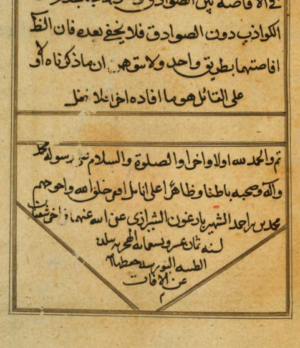

The colophon to the right (from an Ottoman-era book on logic) graphically separates the colophon with ruled lines, and then writes the colophon in a downward-pointing triangle. The seven-line colophon reads as follows:
١ - تم والحمد لله أولا وآخرا والصلوة والسلام على رسوله محمد
٢ - وآله وصحبه باطنا وطاهرًا على أنامل أفقر خلق الله وأحوجهم
٣ - محمد بن پير أحمد الشهير بارغون الشيرازي عفى الله عنهما في آخر شعبان
٤ - لسنة ثمان عشر وتسعمائة الهجرية ببلدة
٥ - الطيبة البورسة حفظها الله
٦ - عن الآفات
٧ - م
Translation:
It was finished - praising God foremost and after all, and praying, aloud and in our hearts for peace and blessings be upon God's Messenger Muhammad and his kin and companions - [copied] by the fingers of the most lowly and needy of God's creation, Muhammad ibn Pir Ahmad, known as Arghun al-Shirazi - May God forgive him - at the end of the Month of Sha'ban in the year 918 of the Hijra, in the good city of Bursa - God protect it from ill!
The End.
Commentary:
This colophon introduces some key and common features. In terms of factual details, it gives the name of the copyist and the date and place of copying, while half of the colophon is devotional formulae. The completion of the copy is immediately followed by thanks to God and supplication for the Prophet and his kin and companions. The copyist prefaces his name by a typical self-effacing expression, and the place is accompanied by prayers for its protection too.
The interlacing of details with devotional formulae is a signature feature of most every Arabic colophon, and sometimes the date can be accompanied with pious wording as well, as we shall see below.
The letter mīm on the final line is an abbreviation for the Arabic word tamma or tatmīm - both meaning "to be completed". This is a common ending abbreviation, you may also encounter the letter hā' (ه), an abbreviation for intaha (to be ended).
Note also that the copyist does not fully point the letters and engages some contractions and abbreviations; these are common features in colophons, perhaps because the expressions are formulaic and/or as a means to further distinguish the style of the colophon from the rest of the text. The signatures of witnesses to a book's oral reading (which were also placed at the end of copies of books) had a long tradition of being written without points and in idiosyncratic script (See Lesson 12), which may also have influenced this writing style for the colophon too.
Common Colophon Terms
The second means to indicate the beginning of the colophon is via a short phrase or verb indicating that the text of the book has been completed and that the copyist's own information in the colophon are about to begin. Identifying these words is the first step to determine the colophon, especially where it is not graphically distinguished from the text.
In the colophon above, the text begins with the verb تم - to be completed. This and the related verb أتم (to be brought completion) is perhaps the most common word, but you can also find other expressions (or a combination of them) at the opening of a colophon:
Some use the term farāgh - "the completion/ending has occurred" in the following phrases, after which the date will be written
وقع الفراغ - the completion "happened"
كان الفراغ - the completion "was on"
وافق الفراغ - the completion "corresponded with" the date that follows
Other common terms are verbs such as ختم and اختتم - to seal - indicating the completion of the work; and the date then follows these phrases too.
Yet another formula appears in the colophon below:
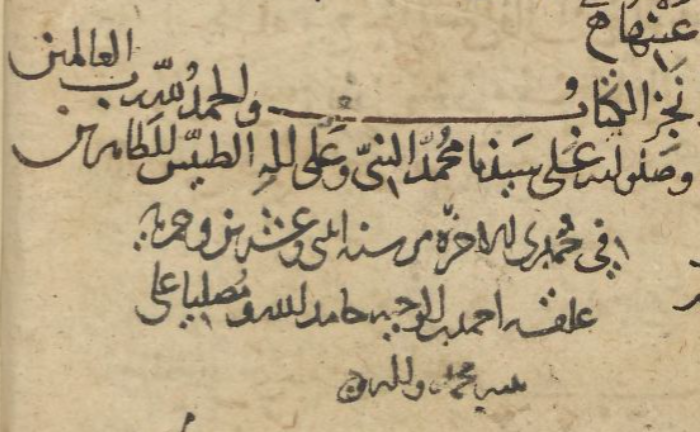
This colophon writes نجز الكتاب - another Arabic synonym for 'bringing to completion'.
نجز الكتاب والحمد لله رب العالمين
وصلواته على سيدنا محمد النبي وعلى آله الطيبين الطاهرين
في جمادى الآخرة من سنت اثنين وعشرين وخمسمائة
علقه أحمد بن الوجيه حامدًا لله ومصليًا على
نبيه وآله
Translation:
This book is complete, and praise be to God, Lord of the Worlds
And may God's peace be upon our lord Muhammad the Prophet and his pure, blessed kin
In the month of Jumadā II in the year 522
It was copied by Ahmad ibn Wajīh, who praises God and supplicates for
His Prophet and his Kin
Commentary:
This is a relatively early manuscript, and the colophon is quite simple, but still the devotional formulae constitute about half of the material.
The copyist's use of the verb "'allaqa" علّق is one of various possible terms used in colophons to indicate the act of copying, also very common are the related verbal noun تعليق and words formed from a synonymous verb for copying - "nasakha", such as نسخ, نساخة and نسخة. The copyist might also use the verb كتب (to write) or حرر (to render). At the present state of research, it is unclear whether these words had really different connotations; they appear to be essentially synonymous.
The small circle with a dot in the centre after the word آله at the end of the colophon is another graphical means of indicating completion.
A Full Colophon
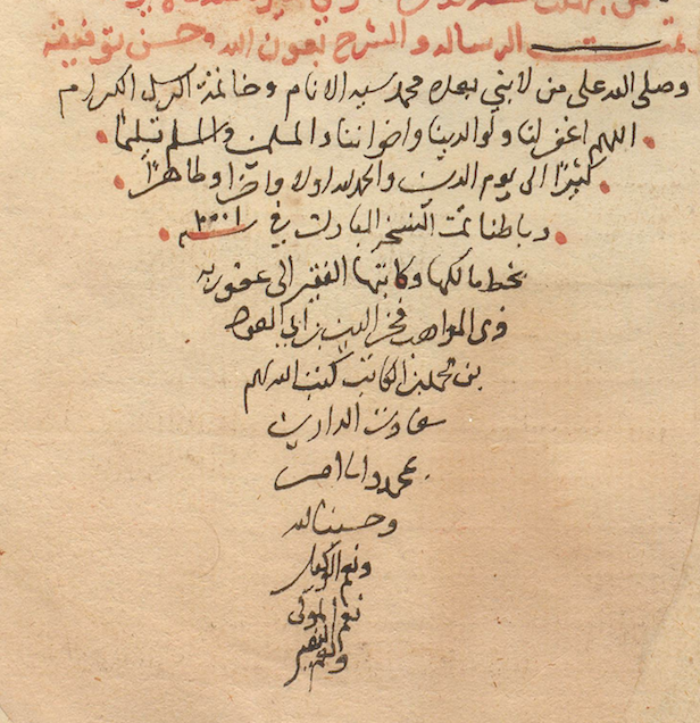
This relatively long colophon contains a number of factual elements plus quite expanded devotional formulae. You can see that individual copyists can expand the amount of devotional formulae as much as they like, in this case it makes a rhyming supplication. The transcription below indicates the core elements of the colophon in bold - these are the features that most often appear across Arabic manuscripts; the expansions of devotional flourish written by this particular copyist are written between brackets. Additional prayers/supplications which sometimes appear in other manuscripts are written in italics,
تمت الرسالة والشرح بعون الله (وحسن توفيقه) وصلى الله على (من لا نبي بعده) محمد (سيد الأنام وخاتمة الرسل الكرام) اللهم اغفر لنا ولوالدينا وإخواننا والمسلمين وسلم تسليمًا كبيرًا إلى يوم الدين والحمد لله (أولًا وآخرًا وظاهرًا وباطنًا) تمت النسخة (المباركة) في سنة ١٠٠١
بخط مالكها وكاتبها الفقير (إلى عفو من ربه ذي المواهب) فخر الدين أبي الفداء بن محمد بن الكاتب (كتب الله لهم سعادة الدارين بمحمد والإسلام وحسبنا الله ونعم الوكيل نعم المولى ونعم النصير)
Translation:
The Letter and the Commentary was completed, with the aid of God and His good grace; peace and blessings on Muhammad - he the last of the Prophets, the lord of humanity, the seal of the noble prophets - and God Almighty forgive us our sins, the sins of our parents and our brother Muslims, and give much blessing until the Day of Judgement to the Prophet. Praise God - first and after all, aloud and in the hearts. The blessed copy was completed in the year 1001, by the hand of the copy's owner and copyist, he who is needy of his Lord's divine forgiveness - Fakhr al-Dīn Abu al-Fida Muhammad ibn al-Kātib; may God have in store for him happiness in this world and the next via his faith in Muhammad and Islam. God is sufficient for us, what a fine provider, what a great lord and protector.
Commentary:
Note in particular the term for the copy نسخة has the devotional adjective of being "blessed" مباركة; the self-effacing reference to the copyist as فقير has additional devotional wording before his name is written, and there are two long prayers added in the middle and the end.
A Double Colophon
The manuscript in the frame above, a book on conical geometry (makhrūṭāt), is a copy of an originally Greek text by Appolonius, which was then expanded and commented upon by Naṣīr ad-Dīn aṭ-Ṭūsī with further commentary and illustrations by Ibn al-Bawwāb al-Baghdādī.
The present copy was made in the early seventeenth century CE, but it preserves the colophon of the original manuscript, and then writes its own colophon particular to this copy. The text uses the same phrases and devotional fomulae we have encountered so far. What is unusual, however, is how the the year of the original manuscript's copying is written - as visible in a detail of the colophon below:

The year is not rendered numerically or alphabetically, but instead is written in alpha-numeric form, according to the numerical values ascribed to Arabic letters.
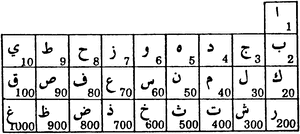

The system is known as "Abjad", and as the letters join to the words, a number can be calculated.
In the manuscript in the frame, we find that the year of the first copy's completion is written سنة تسب
To determine the year, add up the letters of تسب:
ت = 400
س = 60
ب = 2
The copy was written in 462 AH.
Questions
-
Study the colophon of the al-Makhrutat manuscript in the frame at the beginning of this lesson. With what words does the second colophon begin?
-
Where is the date and year written in the second colophon of the al-Makhrutat manuscript, and what is the date?
-
What does the word غلو signify at the very last line of the second colophon of the al-Makhrutat manuscript?
-
The colophon below, from an Ottoman-era copy of the Arabic literary text Sarh al-Uyun by Ibn Nubatah, contains very considerable details. Scan the colophon and find the date: how is it written? How does the copyist describe the month, how does he write the year?
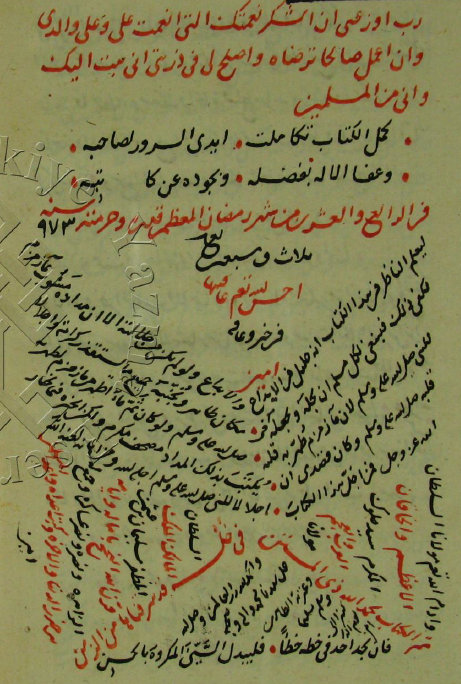
Assignments
-
Find examples of expanded devotional forumlae in the two colophons of al-Makhrūṭāt in the lesson frame. Which details are accorded such expanded elaborations? Translate their meanings.
-
The complex colophon of the Ashir Efendi Sarh al-Uyun manuscript contains very considerable details. Transcribe the colophon.
What kinds of texts constitute the opening 5 lines of the colophon? What information does the densely written text at the lower part of the colophon reveal?

